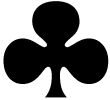Counting Winners, Counting Losers
|
 K J 9 K J 9 |
|
 A K Q 5 4 A K Q 5 4 |
|
 ------ ------ |
|  A Q 8 5 2 A Q 8 5 2 |
 Q 2 Q 2 |
|
 7 4 3 7 4 3 |
 8 7 8 7 | |
 J 6 3 2 J 6 3 2 |
|
 A 7 5 4 2 A 7 5 4 2 | |  K J 8 K J 8 |
 10 9 6 3 10 9 6 3 | |
 K 7 4 K 7 4 |
|
 A 10 8 6 5 A 10 8 6 5 |
|
|
 10 9 10 9 |
|
|
 Q 10 9 6 3 Q 10 9 6 3 |
Contract: 6 spades |
|
 J J |
Opening lead: 3 of clubs |
Here's a hand that popped up a day later, another makable slam if declarer will take care to make certain every card in the South hand is accounted for. That, to be sure, includes an allowance of one loser. I was kibitzing here and on a club lead thought declarer should duck even though I could see it would lose. No, it wasn't hindsight that prompted my thought, nor had I worked out the whole hand. Rather it was the feeling that if you duck, at least you're putting your jack to work. You're getting something for it. You now have A Q of clubs for some no-nonsense winners when trump are gone.
Now accounting for five diamonds doesn't seem quite so onerous. Two go on the top clubs, one goes on the third round of hearts, one can be ruffed, and one can go on the long club if the suit breaks evenly. One declarer who went down did duck that club to the king, and if it wasn't enough that he was started on the right track, he now got a spade lead, eliminating the need to guess for the queen! The hand should have been a piece of cake at that point. The queen of spades drew the king. Ruff a club, ruff a diamond, overtake a spade lead and draw the third round of trump.
Go to the ace of hearts, and when everyone follows to the ace of clubs, your contract is secure. You sluff three diamonds on the clubs and a fourth on the third round of hearts and claim.
This declarer got off on the wrong track, however, after such a promising start. He went after hearts rather than clubs. Why is that wrong? Well, principally because if you set up clubs, you have an entry back in hearts. But if you hit hearts, you can't get back with a club lead. He couldn't ruff a diamond and be in dummy when all trump were out if he went after hearts.
Hence, he should ruff a club, ruff a diamond, overtake a trump, as outlined above, and now if either hearts or clubs break evenly he'll have all the winners he needs. Incidentally, a simple count of winners might have warned this declarer. If he ruffs the third round of hearts, he can't have more than four heart winners. If he doesn't ruff in the short hand, he can't have more than 5 spade winners. That's nine. And he's got the top two clubs. Let's see now. Couldn't the 10 9 fall in two more rounds? Yeah, right. Possible, but . . .
Declarer played to have only 11 winners. That 12th wasn't going to drop out of thin air because you have no obvious loser. You need a 12th winner.
Footnote: This could have worked also as a dummy reversal. After all, you need ruff only one heart and one club, and on the 3-2 spade split you can. This declarer, after capturing the queen of spades with the king made the mistake of cashing the jack of spades and then ruffing the third round of hearts. Now he doesn't have the entries he needs to get to dummy, ruff a club and get back. At trick three, he could cash two rounds of hearts, ruff a heart high, back to the 9 of spades, ruff a club, back to the jack and everything runs. Now his winners are four hearts, three clubs and five spades.
It's not your classic dummy reversal, but it works, looking at the North hand where you make every card (but one) either a winner or played on a winner in the South hand (in this case only the two ruffs would fit that criterion). But it works also to do the same with the closed hand. Since the first round of clubs was lost, every diamond must be matched with a winner in the North hand, and this is done by one ruff, the third round of hearts, the top two clubs and the long club. Presto.